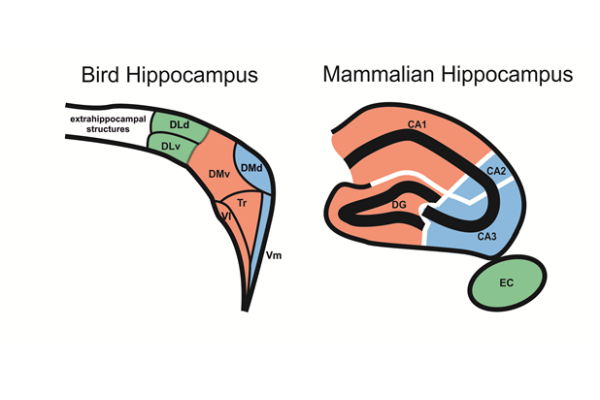2014-01-29

The evolutionary lines of birds and mammals diverged nearly 300 million years ago. As a consequence, the brains of these two classes of vertebrates share some features but also have many unique and non-shared properties. The hippocampus is an especially interesting case: the hippocampus of mammals and birds is homologous and thus stems from a common reptilian ancestor that already had a hippocampus. As a result, avian and mammalian hippocampi share some similar functions (e.g. spatial cognition) and anatomical features (e.g. a re-entrant loop). But they also developed a large number of bird- or mammal-typical aspects that do not seem to have counterpart. Overall, it is still mostly unknown which components of the bird hippocampus are avian-unique and which are similar to mammals. To solve these questions, scientists from Bochum, Düsseldorf, and Bowling Green (USA) analyzed binding site densities for 11 different receptor systems by using quantitative in vitro receptor autoradiography. Additionally, they labeled zinc to show a further compartmentalization of the hippocampus. The regionally different receptor densities mapped well onto seven hippocampal subdivisions previously described. Several differences in receptor expression highlighted distinct hippocampal subfields. In addition, several similarities in receptor binding densities between subdivisions of the avian and mammalian hippocampus were observed. Despite the similarities, the consortium of scientists concluded that 300 hundred million years of independent evolution has led to a vast mosaic of similarities and differences in the organization of the avian and mammalian hippocampal formation. Thinking about the avian hippocampus in terms of the strict organization of the mammalian hippocampus is likely insufficient to understand the hippocampus of birds.

The evolutionary lines of birds and mammals diverged nearly 300 million years ago. As a consequence, the brains of these two classes of vertebrates share some features but also have many unique and non-shared properties. The hippocampus is an especially interesting case: the hippocampus of mammals and birds is homologous and thus stems from a common reptilian ancestor that already had a hippocampus. As a result, avian and mammalian hippocampi share some similar functions (e.g. spatial cognition) and anatomical features (e.g. a re-entrant loop). But they also developed a large number of bird- or mammal-typical aspects that do not seem to have counterpart. Overall, it is still mostly unknown which components of the bird hippocampus are avian-unique and which are similar to mammals. To solve these questions, scientists from Bochum, Düsseldorf, and Bowling Green (USA) analyzed binding site densities for 11 different receptor systems by using quantitative in vitro receptor autoradiography. Additionally, they labeled zinc to show a further compartmentalization of the hippocampus. The regionally different receptor densities mapped well onto seven hippocampal subdivisions previously described. Several differences in receptor expression highlighted distinct hippocampal subfields. In addition, several similarities in receptor binding densities between subdivisions of the avian and mammalian hippocampus were observed. Despite the similarities, the consortium of scientists concluded that 300 hundred million years of independent evolution has led to a vast mosaic of similarities and differences in the organization of the avian and mammalian hippocampal formation. Thinking about the avian hippocampus in terms of the strict organization of the mammalian hippocampus is likely insufficient to understand the hippocampus of birds.